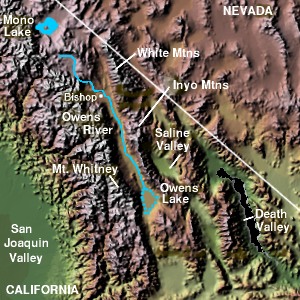Inyo Mountains facts for kids
Quick facts for kids Inyo Mountains |
|
|---|---|

Inyo Mountains from space
|
|
| Highest point | |
| Peak | Waucoba Mountain (~18 mi (29 km) southeast of Big Pine.) |
| Elevation | 11,123 ft (3,390 m) |
| Dimensions | |
| Length | 70 mi (110 km) |
| Width | 10 mi (16 km) |
| Geography | |
| Country | United States |
| Parent range | Basin and Range Province |
The Inyo Mountains are a mountain range in eastern California, United States. They are located just east of the tall Sierra Nevada mountains. This range helps separate two valleys: the Owens Valley to the west and the Saline Valley to the east.
The Inyo Mountains stretch for about 70 miles (110 km). They begin near the southern part of the White Mountains. A place called Westgard Pass separates these two mountain ranges. The Inyo Mountains also sit to the east of Owens Lake.
These mountains were formed by a process called fault-blocking. This means large blocks of the Earth's crust moved up or down along cracks called faults. The Inyo Mountains are part of a larger area known as the Basin and Range Province. This region covers much of the western United States and is known for its many mountain ranges and flat valleys.
Inyo Mountain Wilderness
A large part of the Inyo Mountains is a protected area called the Inyo Mountain Wilderness. This wilderness covers about 199,208 acres (806 km²). It is managed by two groups: the Bureau of Land Management in the southern part and the United States Forest Service in the northern part. The Forest Service looks after about 73,300 acres (297 km²) of this wilderness, which is inside the Inyo National Forest.
This wilderness area is important for many reasons. It helps protect the natural environment and the animals and plants that live there.
Wildlife and Plants
The Inyo Mountains are home to many interesting animals and plants. Some of these are very special and can only be found here.
One important animal is the Inyo Mountains Salamander. This small creature is an endangered species, meaning it is at risk of disappearing forever. Another animal you might see is the Desert bighorn sheep. These sheep are known for their large, curving horns.
The types of plants you find change with the height of the mountains. At lower elevations, you can see plants like creosote bush and sagebrush. Higher up, you might find forests of bristlecone pine trees. These trees are famous for living a very long time.
Some plants in the Inyo Mountains are endemic. This means they grow naturally only in this specific area. They have adapted to the special limestone soils found here. Examples include the cliffdweller, bristlecone cryptantha, and Inyo rock daisy.
Images for kids




